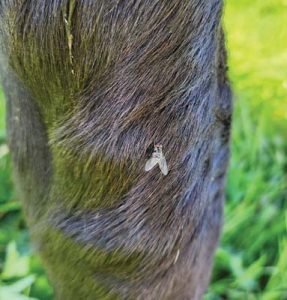Are biting flies a nuisance on your farm?
There’s a fly that hangs around cows at milking and it’s irritating to both humans and bovines, writes vet Lisa Whitfield.


Nuisance biting flies are an annual headache on farms over summer and autumn months. Irritable cows, reduced feed intake reducing milk production, heat stress, and paddocks damaged from mobbing stock are just a few of the issues which result from a booming biting fly population.
In addition, they cause elevated levels of frustration in people when milkings become disturbed by cows kicking and flies which readily bite people too.
The offending fly is Stomoxys calcitrans – also known as the stable fly.
This little pest is similar in appearance and size to the common house fly, but has mouthparts adapted to pierce through skin so it can feed on blood. The common housefly, Musca domestica, has mouthparts which gently sponge up its meals from surfaces.
When you look closely at the udder of a cow which is being bothered by biting flies, you will notice blood spots, which gives a good indication of how deep their bite goes – no wonder cows hate them so much.
Adult biting flies live for ~20-25 days. Egg-laying can occur as soon as four days after emergence, and the time from egg laying to adult fly emergence is about 19 days. The flies feed on blood within 24 hours of emergence, and in large numbers have been known to cause anemia (low level of red blood cells) in livestock. Each fly consumes ~12μL of blood per meal, and will feed up to twice a day.

Eggs are laid in areas with rotting organic matter. On the dairy farm, think about areas such as the edge of silage pits, waste feed and bedding piles and areas with a build-up of old manure. Rotting silage can support the development of up to 2000 flies per square metre.
The spread of skin infections such as ringworm and dermatophilosus (rain scald) can occur more readily where biting flies are a problem.
We are lucky here in New Zealand that we do not have the more serious diseases which can be transmitted by these flies overseas. Quantification of the full economic impact of biting flies under NZ’s pasture-based dairy system has not been done.
Peak fly numbers coincide with the tail end of lactation, drought season, facial eczema season, and rising bulk tank cell counts, making financial impact evaluation more difficult. Visible benefits such as less kicking and irritation from cows during milking, relaxed grazing behaviour in the paddock and better working conditions for staff are hard to put a price on, however.
Nuisance fly control is best achieved when management measures are put in place early in the season. By starting early you can knock out the establishing generations which exponentially multiply as the season progresses.
In practice this means starting with control measures before Christmas. Once a fly population is well established it is harder to knock it back due to the sheer numbers involved, and treatments may appear less effective as a result. Consider that if each female fly produces on average just 16 living female flies per generation, after five generations a single female will have generated a further one million living female flies.
If we can kill flies in the first or second generation, we will have a significant impact on total numbers which develop by the end of the season.
Management measures should include spraying with insecticides around fly breeding grounds, topical treatments applied regularly to stock, and fly traps around the shed.
Stock treatment is most readily achieved with synthetic pyrethrin pour-ons or spray. This method is cheap on a per-cow basis and will rapidly provide a return on investment if cows are able to be kept comfortable and maintain their feed intake.
With treatments lasting up to 30 days per application, and at about $2.20 per animal – the return is achieved by maintaining just 0.25 of a milksolid over the treatment period. Just be aware of the significant withholding period of 28 days on these products – make sure you know who your cull cows are and when they are likely to be leaving the farm.




